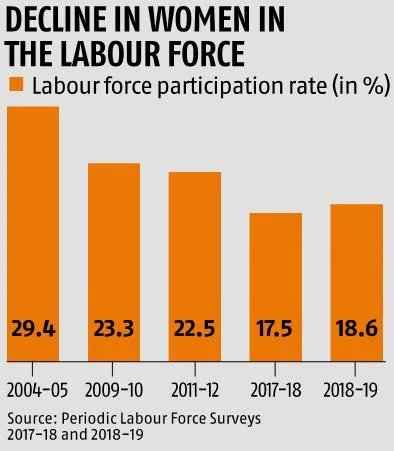The decline in female workforce participation in the country has historical precedence. The female labour force participation rate (FLFPR) was recorded at 24.1 percent shortly after Independence in 1955. In 1972, the FLFPR had increased to 33 percent, after which it steadily declined and fell to its lowest level in 2017 at 23 percent. The gender gap in India’s labour force, attributed largely to conservative social norms and due to both demand side (work opportunities) and supply side (availability of women for work) factors, remains the most persistent paradox of recent decades. This is despite increased economic growth, a decrease in fertility rates and increased enrolment of women in higher education over decades. The exclusion of women from paid work has resulted in perpetual gender inequality in the economy. Traditionally, women in India have largely been employed in labour-intensive, low-paid, informal work without social security. The declining trend in female workforce participation in India is influenced by a complex interplay of socio-cultural, economic, and policy-related factors. Here are some key reasons:
1. Socio-Cultural Factors:
- Gender Norms and Patriarchy: Traditional gender roles and patriarchal norms often dictate that women should prioritize household responsibilities and caregiving over formal employment.
- Marriage and Childbearing: Women often leave the workforce after marriage or childbirth due to societal expectations and lack of support systems like affordable childcare.
- Safety and Mobility Concerns: Safety concerns and lack of reliable transportation options can restrict women’s ability to commute to work, especially in rural areas and smaller towns.
2. Economic Factors:
- Low Wages and Poor Working Conditions: Many available jobs, especially in the informal sector, offer low wages and poor working conditions, making them less attractive for women.
- Lack of Skill Matching: There is often a mismatch between women’s skills and the available job opportunities. Many women may have skills that are not in demand, leading to their exclusion from the workforce.
- Economic Contraction: Economic downturns or slow growth periods can disproportionately affect sectors that employ a significant number of women, leading to job losses or reduced hiring.
3. Educational Factors:
- Educational Attainment: While there has been progress in female education, disparities in higher education attainment still exist. Women with lower levels of education may find fewer employment opportunities.
- Field of Study: Women often pursue fields of study that are less in demand in the job market, such as humanities and social sciences, as opposed to STEM fields that offer more lucrative job opportunities.
4. Policy and Institutional Factors:
- Inadequate Labor Laws: Insufficient or poorly enforced labor laws and regulations can make the workplace environment hostile or non-conducive for women.
- Lack of Supportive Policies: Insufficient maternity leave, lack of paternity leave, and inadequate workplace childcare facilities can force women to leave the workforce.
- Informal Sector Employment: A significant proportion of women work in the informal sector, which lacks job security, benefits, and social protection.
5. Technological and Structural Changes:
- Automation and Technological Advancements: The shift towards automation and the digital economy can disproportionately affect jobs traditionally held by women, leading to job losses in these areas.
- Structural Transformation: The shift from agriculture to industry and services can displace women who predominantly work in agriculture, without providing adequate re-skilling or new job opportunities.
6. COVID-19 Impact:
- Pandemic Disruptions: The COVID-19 pandemic has exacerbated the decline in female workforce participation, with women bearing the brunt of job losses, increased domestic responsibilities, and school closures requiring more caregiving at home.
Addressing these challenges requires a multi-faceted approach, including gender-sensitive policies, improved safety and infrastructure, better education and skill development opportunities, and supportive workplace practices.


